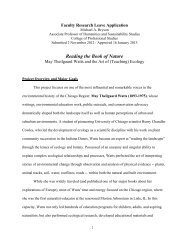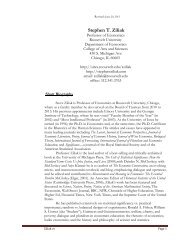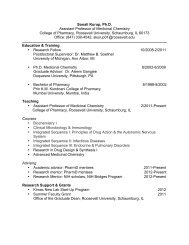Social Insurance and Public Assistance
public-assistance-welfare-reform-colonial-times-to-the-present-ziliak ...
public-assistance-welfare-reform-colonial-times-to-the-present-ziliak ...
You also want an ePaper? Increase the reach of your titles
YUMPU automatically turns print PDFs into web optimized ePapers that Google loves.
SOCIAL WELFARE: 1929 TO THE PRESENT 701<br />
(see Skocpol 1992; Orloff 1993). During the Progressive era in the<br />
early 1900s, reformers pressed state governments for an extensive<br />
series of social welfare programs, including workers’ compensation<br />
laws, unemployment insurance, state-provided health insurance,<br />
old-age pensions, <strong>and</strong> mothers’ aid pensions for widowed<br />
mothers. Of all these programs, only workers’ compensation <strong>and</strong><br />
the mothers’ aid pensions were adopted in a large number of states<br />
by 1929. By the mid-1930s a number of states had adopted oldage<br />
relief plans, while only Wisconsin had enacted unemployment<br />
insurance, <strong>and</strong> they had not yet started paying benefits by the time<br />
the <strong>Social</strong> Security Act established unemployment insurance as a<br />
joint federal–state program.<br />
Prior to the Great Depression, social insurance <strong>and</strong> many social<br />
welfare activities were not considered to be under the purview<br />
of the federal government. When the Great Depression led to<br />
an unemployment rate of nearly 25 percent in 1933, Franklin<br />
Roosevelt <strong>and</strong> the New Dealers made the argument that the Depression<br />
was a national emergency that must be dealt with using<br />
federal programs. The New Deal provided emergency assistance<br />
to large numbers of unemployed workers <strong>and</strong> then in 1935 established<br />
several long-term social insurance programs with the <strong>Social</strong><br />
Security Act. Federal actions during the 1930s set precedents for<br />
the expansion of the federal government into additional programs<br />
that were introduced in later years. After the federal government<br />
became involved in the social welfare business, the collection of<br />
statistics aggregated to a national level exp<strong>and</strong>ed rapidly. Consequently,<br />
most of the statistics presented in this chapter are from<br />
1929 to the present. Few national statistics are available for the<br />
earlier periods. There was enormous variation across cities, counties,<br />
<strong>and</strong> states in the provision of such services, <strong>and</strong> we have only<br />
shreds of evidence available.<br />
It is important to offer a caveat about use of the statistics on social<br />
welfare expenditures. The vast majority of the statistics available<br />
on social welfare spending are reported by the SSA in the<br />
<strong>Social</strong> Security Bulletin <strong>and</strong> the <strong>Social</strong> Security Bulletin Annual<br />
Supplement. The first lesson to be learned in examining the long<br />
time series is that the series are often revised in response to new<br />
data, methods, <strong>and</strong> conceptual definitions. The SSA often publishes<br />
the revised versions of the recent data, but in many cases it offers<br />
revised information for only those earlier years ending in 0 <strong>and</strong> 5.<br />
In most cases, we try to present the revisions that were available<br />
through 1997. Discussions with the people at the SSA who compile<br />
the statistics suggest that a search for “the” number in any single<br />
year would be futile. The numbers are estimates from surveys, reports<br />
of other agencies, <strong>and</strong> other sources. In a number of settings,<br />
the fundamental information is collected only every second, third,<br />
fifth, or tenth year, <strong>and</strong> the observations for the intervening years<br />
are interpolations. Thus, the reported observations for each year<br />
should be treated as rough approximations of the “true” level. The<br />
people at the SSA are careful to try to maintain consistency in the<br />
definitions of the series. However, even the revisions are subject<br />
to measurement error, <strong>and</strong> year-to-year fluctuations between a revised<br />
statistic for a year ending in 0 or 5 with neighboring years<br />
are likely to be subject to measurement error. There is some comfort<br />
in our finding that many of the revisions are within 3 percent<br />
of the prior reported estimates. This caveat suggests that the data<br />
are useful for showing long-term trends over decades but are more<br />
sensitive to measurement error in examining year-to-year changes.<br />
A preliminary word on the organization of tables is also in order.<br />
Tables Bf188–270 report annual information on social welfare<br />
spending under public programs based on the OECD definitions<br />
for the period 1929 to the mid-1990s. The tables offer a breakdown<br />
of social welfare spending for programs under each of the broad<br />
categories of social insurance, public aid, health <strong>and</strong> medical programs,<br />
veterans’ programs, education, public housing, <strong>and</strong> other<br />
programs. Many of the programs are funded by several layers of<br />
government; therefore, Table Bf196–211 shows the extent to which<br />
federal <strong>and</strong> state or local governments provide the funding for each<br />
of the broad categories. Governments are not the only source of<br />
social welfare spending. Tables Bf773–892 offer information on<br />
social welfare spending by private entities, which account for as<br />
much as 13 percent of gross domestic product (GDP) in today’s<br />
economy. Tables Bf271–772 offer information about specific public<br />
programs: the numbers of people affected, the monies spent,<br />
<strong>and</strong> the sources of funding. There are a large number of tables<br />
in this area because the development of social welfare programs<br />
over the course of the twentieth century has been complicated. The<br />
federal, state, <strong>and</strong> local governments have developed an array of<br />
programs to meet different aspects of social welfare. Views have<br />
changed about the optimal way to meet these goals. As a result,<br />
long-term programs have been redesigned, <strong>and</strong> even if they have<br />
kept the same name, the nature of data collection for the new goals<br />
changes the series collected. In other cases, new agencies are developed<br />
to take over the duties of the original program. Finally,<br />
new programs are added to the list. This has led us in some cases<br />
to report multiple overlapping series on the same issues.<br />
Aggregate Trends<br />
The dramatic increase in public social welfare spending in the<br />
United States has been one of the major economic trends in the<br />
twentieth century. The broadest conceptual measure of public social<br />
welfare spending is in series Bf188, which is the series collected<br />
by the SSA to be compatible with the OECD/ILO definitions<br />
of public social welfare spending. Between 1929 <strong>and</strong> 1993, social<br />
welfare spending in public programs in 1992 dollars (adjusted for<br />
inflation by the GDP deflator) has grown at an average annual rate<br />
of 6.1 percent per year, nearly double the annual average growth<br />
rate of 3.3 percent for real GDP. 1 To give a sense of the size of<br />
public social welfare spending, it is useful to compare it to the<br />
overall size of the economy by describing the spending as a comparative<br />
percentage to GDP. There is one important caveat about<br />
this comparison. When social welfare expenditures are compared<br />
to GDP in percentage terms, it should not be presumed that this is<br />
the contribution of social welfare expenditures to GDP. The GDP is<br />
defined as the market value of the output of final goods <strong>and</strong> services<br />
in the economy, while a significant percentage of the social welfare<br />
expenditures are transfer payments that would not be considered<br />
as additions to the final goods <strong>and</strong> services measured by the GDP.<br />
1 The annual average growth rate for social welfare spending between 1929 <strong>and</strong><br />
1993 is calculated as [(S 1993 /S 1929 ) (1/(1993−1929)) – 1]*100, where S year refers<br />
to the value for the variable in that year. All other average annual growth rates<br />
in the chapter are calculated in the same way using the endpoints of the period<br />
examined. The information on nominal GDP, GDP in 1992 dollars, <strong>and</strong> the<br />
GDP deflator used to convert nominal dollars to 1992 dollars is derived from<br />
the nominal <strong>and</strong> real GDP series rounded to billions of dollars that formed the<br />
basis for the tables in the Council of Economic Advisors, Economic Report of<br />
the President Transmitted to Congress February 1998, pp. 280–2. In Chapter<br />
Ca, there is an updated set of GDP numbers.









